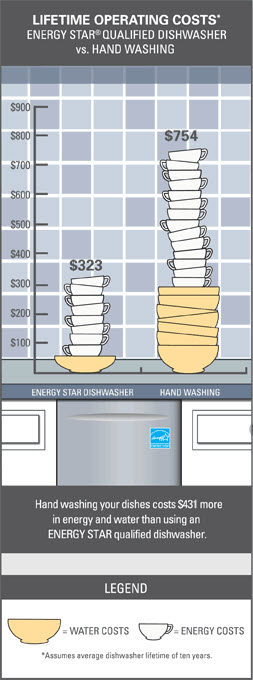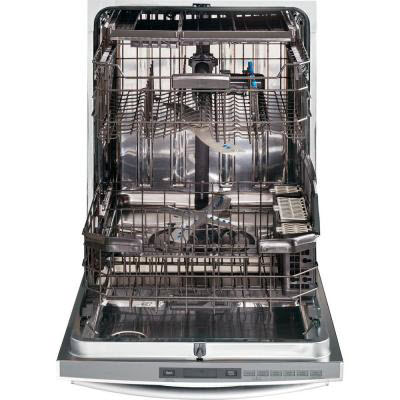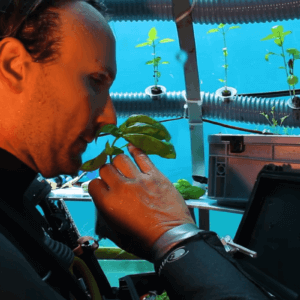
Arguably, the dishwasher is the most eco-friendly of our large household appliances. Not because it doesn’t slurp up energy and water, but because it improves on the alternative. Hand washing your dishes actually uses more water and energy than running your dishwasher. A full load of dishes run through a modern dishwasher and allowed to air dry uses 35 percent less water than hand washing (source). Of course there’s the environmental impact of producing a dishwasher and the dubious recyclability of some of the components to contend with, but the longevity of these appliances (10-15 years), negates a lot of that impact.

Despite its upfront eco-cred however, there is still much that can be done to improve the efficiency of your dishwasher. Read on for tips for buying the best dishwasher for the planet.
Choose Energy Star Rated Models
As with most Energy Star rated appliances, the program has procured giant leaps in efficiency from the manufacturers. Twenty years ago, dishwashers used 10 gallons of water or more per cycle. Today they must use no more than 4.25 gallons to qualify as Energy Star, and many use much less. The less water used, the less energy needed to heat the water, meaning Energy Star dishwashers use less than 295 kWh/year, or 1.37 kWh per cycle.
Remember the Water
An average family spends 14 percent of their monthly energy bill on hot water. Heating water is the third largest energy expense in the home (source). Just over 50 percent of the energy a dishwasher uses goes towards heating the water before it even reaches the dishwasher. Thirty percent is then used to boost the water temperature inside the dishwasher to 140 degrees, and the rest is used by the drying cycle and to power the pumps etc. within the machine (source). Bearing all this in mind, look for the following features when purchasing your next dishwasher to cut down on energy and water usage.
Eco-Friendly Features
Delay Start:
This feature allows you to program your dishwasher to run during off peak hours, saving money on electricity usages and putting less strain on the grid.
Soil Sensing:
Units with sensor technologies adjust the cycle time and water use to the level of dirt on the dishes. This helps with efficiency as long as you scrape (not rinse) your dishes thoroughly.
Multiple Cycles:
Choose a dishwasher with several wash cycle options. If your dishes are only slightly soiled, you can use a light or energy-saving wash cycle, which uses less water and operates for a shorter period of time. Rapid wash cycles offer added efficiency and some manufacturers feature a specific eco-friendly mode, such as GE’s eWash.
Bigger is Better:
Standard-capacity models hold more than eight place settings and six serving pieces, some, such as the GE Profile, hold up to 16 place settings. These larger models often offer a top or bottom rack only wash, which use the same amount of energy as a compact model. So, unless space is an option, a standard or larger dishwasher is better than a compact model, as you’ll likely use a smaller washer more frequently.

Air Dry:
Avoid dishwashers with heating elements; these are huge energy guzzlers. Opt instead for an air-dry option that employs circulation fans to boost the effectiveness of the drying cycle without drawing more electricity.
Stainless Steel Tub:
Along with being more durable than traditional plastic interiors, stainless steel tubs reflect heat to optimize energy efficiency during the drying cycle.
Water Recycling:
KitchenAid debuted its innovative AquaSense water recycling system last year. Already a common feature in Europe, the system recaptures water from the final rinse of a cycle and, after filtering it, stores it to use for pre-rinsing the next load. With this technology, KitchenAid’s KDTE554CSS model uses just 1.64 gallons of hot water. While not perfect – this review details some energy issues – the technology is certainly something to keep an eye on.
Top Tips
Once you’ve got that sleek new energy-efficient, water-saving dishwasher in place, here are some tips to using it to its full eco-friendly potential:
Scrape don’t rinse:
Scrape food off dishes rather than rinsing in the sink. This can save 20 gallons of water before the dishes are even in the dishwasher. Modern dishwashers and detergents are powerful enough to get all the grime off. If yours isn’t doing the job, it’s time for a new one.
Dispense with the pre-rinse cycle:
Unless you left your dishes out overnight, don’t use a pre-rinse cycle; it wastes water and time.
Select the right cycle:
If you’ve scraped, the light cycle will be sufficient. Don’t use super settings like “Power Scrub” or “Pots and Pans.”
Load it up:
Most dishwashers use about the same amount of energy and water regardless of the number of dishes inside, so run full loads whenever possible.
Skip the heat:
Select the no-heat drying option. It gives good drying results with less energy. If it’s not dry enough for you, time the cycle so you can leave the dishwasher open overnight to air dry thoroughly.
Location:
Don’t put your new dishwasher right next to your fridge, the fridge will have to work harder when the dishwasher is running, due to the heat it emanates.
Conclusion
As with a lot of green choices, saving water and energy is mainly about common sense, but many of the new technologies and features in modern dishwashers make upgrading the truly sensible option.
Jennifer Tuohy writes on energy-saving appliances for Home Depot, including kitchen appliances such as ranges, refrigerators and dishwashers. Home Depot’s large selection of dishwashers, including the most energy-efficient types mentioned in Jennifer’s article, can be viewed at http://www.homedepot.com/b/Appliances-Dishwashers/N-5yc1vZc3po.










































I understand it has nothing to do with dishwasher, but it has everything to do with Eco-friendliness. Use biodegradable preferably organic dishwasher detergent. Just imagine the amount of chemicals that people wash down the drain every day!